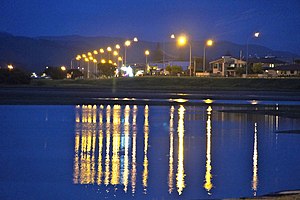Ahuriri
Ahuriri | |
|---|---|
 Ahuriri viewed from Westshore Beach | |
 | |
| Coordinates: 39°28′53″S 176°53′53″E / 39.481459°S 176.897960°E | |
| Country | New Zealand |
| City | Napier |
| Local authority | Napier City Council |
| Electoral ward | Ahuriri Ward |
| Area | |
| • Land | 98 ha (242 acres) |
| Population (June 2024)[2] | |
| • Total | 1,080 |
| Westshore | (Hawke Bay) | |
|
|
||
| Onekawa | Hospital Hill | Bluff Hill |
Ahuriri is a suburb of the city of Napier, in the Hawke's Bay region of New Zealand's eastern North Island.[3]
The area was a major site of Māori and European settlement, and the site of the Port of Napier until the 1931 Hawke's Bay earthquake. It has since been redeveloped as a mixed commercial and residential area.[4]
Demographics
[edit]Ahuriri covers 0.98 km2 (0.38 sq mi)[1] and had an estimated population of 1,080 as of June 2024,[2] with a population density of 1,102 people per km2.
| Year | Pop. | ±% p.a. |
|---|---|---|
| 2006 | 858 | — |
| 2013 | 1,089 | +3.46% |
| 2018 | 1,161 | +1.29% |
| Source: [5] | ||

Ahuriri had a population of 1,161 at the 2018 New Zealand census, an increase of 72 people (6.6%) since the 2013 census, and an increase of 303 people (35.3%) since the 2006 census. There were 510 households, comprising 528 males and 630 females, giving a sex ratio of 0.84 males per female. The median age was 59.4 years (compared with 37.4 years nationally), with 108 people (9.3%) aged under 15 years, 138 (11.9%) aged 15 to 29, 432 (37.2%) aged 30 to 64, and 486 (41.9%) aged 65 or older.
Ethnicities were 92.0% European/Pākehā, 10.6% Māori, 0.8% Pacific peoples, 2.8% Asian, and 1.6% other ethnicities. People may identify with more than one ethnicity.
The percentage of people born overseas was 18.3, compared with 27.1% nationally.
Although some people chose not to answer the census's question about religious affiliation, 45.0% had no religion, 44.7% were Christian, 0.8% had Māori religious beliefs, 0.8% were Hindu, 0.3% were Muslim, 0.3% were Buddhist and 1.6% had other religions.
Of those at least 15 years old, 231 (21.9%) people had a bachelor's or higher degree, and 195 (18.5%) people had no formal qualifications. The median income was $31,300, compared with $31,800 nationally. 189 people (17.9%) earned over $70,000 compared to 17.2% nationally. The employment status of those at least 15 was that 417 (39.6%) people were employed full-time, 114 (10.8%) were part-time, and 21 (2.0%) were unemployed.[5]
Education
[edit]Port Ahuriri School is co-educational Year 1–6 state primary school,[6][7] with a roll of 264 as of August 2024.[8][9] The school started in 1868.[10]
References
[edit]- ^ a b "ArcGIS Web Application". statsnz.maps.arcgis.com. Retrieved 17 February 2023.
- ^ a b "Aotearoa Data Explorer". Statistics New Zealand. Retrieved 26 October 2024.
- ^ NOTE: the term Ahuriri is also used as an alternative Māori language name for the city of Napier overall.
- ^ "About > History". ahuriri.co.nz. Ahuriri Business Association. Archived from the original on 7 June 2019. Retrieved 7 June 2019.
- ^ a b "Statistical area 1 dataset for 2018 Census". Statistics New Zealand. March 2020. Ahuriri (212900). 2018 Census place summary: Ahuriri
- ^ "Official School Website". portahuriri.school.nz.
- ^ "Ministry of Education School Profile". educationcounts.govt.nz. Ministry of Education.
- ^ "New Zealand Schools Directory". New Zealand Ministry of Education. Retrieved 17 September 2024.
- ^ "Education Review Office Report". ero.govt.nz. Education Review Office.
- ^ "Port Ahuriri School Centennial Celebrations 1868-1968". Knowledge Bank. Retrieved 17 February 2023.
